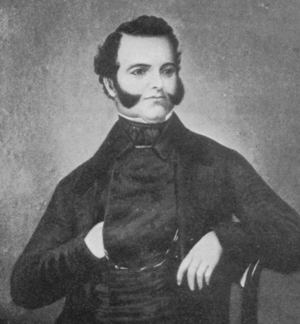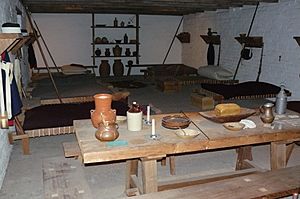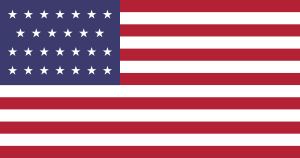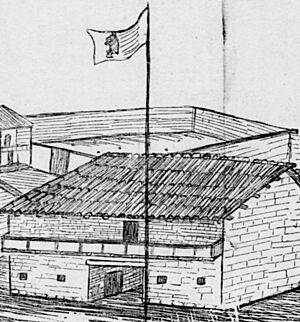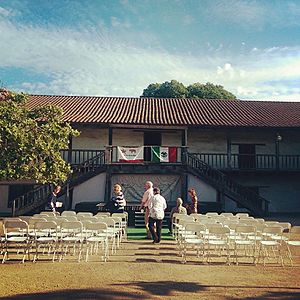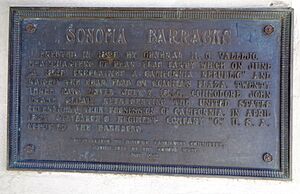Sonoma Barracks facts for kids
Quick facts for kids Sonoma Barracks |
|
|---|---|
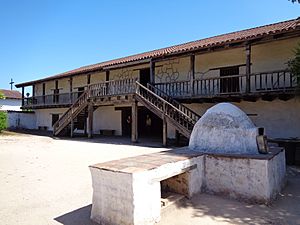
Sonoma Barracks in 2018
|
|
| Location | Spain Street & First Street East, Sonoma, California |
| Built | 1836 |
| Reference no. | 316 |
| Lua error in Module:Location_map at line 420: attempt to index field 'wikibase' (a nil value). | |
The Sonoma Barracks is a two-story building with a wide balcony. It is made of adobe bricks. This historic building faces the main plaza in Sonoma, California. Its Spanish name is Cuartel de Sonoma.
A leader named Mariano Guadalupe Vallejo ordered the barracks built in 1836. It was for Mexican soldiers who moved from the Presidio of San Francisco in 1835. Vallejo and his soldiers also helped manage Native American groups. These groups lived near the northern border of Mexican California.
On June 14, 1846, American settlers took over Sonoma. They wanted to create their own country called the California Republic. The barracks became their main base during this short event. It is now known as the Bear Flag Revolt.
Later, U.S. ships took over Monterey on July 7, 1846. They also took Yerba Buena (now San Francisco) on July 9. The U.S. flag was raised at the barracks on that same day. This ended the California Republic and the Bear Flag Revolt. U.S. forces then used the barracks until 1852. During the Mexican–American War and the California Gold Rush, these forces continued to interact with Native Americans.
After the military left, the building was used for many different things. The State of California bought it in 1957. Today, the Sonoma Barracks is part of Sonoma State Historic Park.
Contents
Mexican Military History
In 1835, Mexican soldiers moved to the area of the old Mission San Francisco Solano. California Governor Jose Figueroa ordered them to move north. He wanted a strong military base north of San Francisco Bay. This base would protect the area from other countries. One concern was the Russian America Company moving eastward from their California settlements.
Building the barracks took several years. Digging the foundation started in 1837. The adobe walls were built in 1839. The building was mostly finished by 1840 or 1841. Before it was ready, the soldiers lived in the old Mission buildings. The barracks was built for soldiers, but much of it was used for headquarters. It also stored supplies, equipment, and weapons.
The commander of the soldiers was Lieutenant Mariano Guadalupe Vallejo. He was put in charge of the Northern Frontier. This meant he was responsible for Native American groups north of the Bay. Vallejo used different ways to control the border region. He used military action and made treaties with Native groups. He also formed alliances with Native leaders like Chief Marin and Chief Solano. Chief Solano even provided extra men when Vallejo's company fought other Native groups.
While based in Sonoma, Vallejo's company took part in over 100 actions. These actions helped keep control over the Native peoples in the area. Historians have said that Vallejo's approach to Native policy was very good and effective.
The Mexican and California governments gave some money and supplies to the company. However, Vallejo often paid for extra costs himself. By the time the San Francisco Company moved to Sonoma, other military companies in Alta California had been replaced by civilian groups.
Lieutenant Colonel Vallejo ended the Presidial Company on November 28, 1844. He said he could no longer afford to pay them. He might also have wanted to avoid a rebellion against Governor Manuel Micheltorena. This rebellion was led by his nephew Juan Bautista Alvarado and friend José Castro. After letting the soldiers go, Vallejo kept the weapons and supplies. These were stored in the barracks for the local civilian militia. This included cannons, muskets, and ammunition.
For a short time, the Sonoma Barracks was also home to another Mexican infantry company. This group was made up of young Californio men who were drafted into service.
The Bear Flag Revolt
On June 10, 1846, a group of American settlers captured some horses. These horses belonged to the Californian government. The settlers were worried the horses would be used against them. They then decided to take over the town of Sonoma. This would stop the Californians from gathering their forces north of San Francisco Bay. Capturing the weapons in the barracks and taking Lieutenant Colonel Vallejo would slow down any Californian military response.
Before dawn on Sunday, June 14, 1846, thirty-three American rebels arrived in Sonoma. They achieved their goals without firing a single shot by 11:00 AM. Vallejo and three of his friends were put on horses. They were taken to John Charles Frémont near Sacramento. Eight or nine of the rebels who did not want a new republic went with them.
The barracks became the headquarters for the remaining twenty-five rebels. They started the new California Republic and created its Bear Flag. This rebellion later became known as the Bear Flag Revolt.
Other settlers and their families began moving into Sonoma. They wanted the protection of the muskets and cannons taken from the barracks. Some families lived in the barracks. Others stayed in the homes of the Californians.
Captain John Charles Frémont and his mapping group arrived in Sonoma on June 24. This showed he was no longer neutral. On July 5, Frémont suggested that the "Bears" (the rebels) join his group. They would form one military group under his command. A written agreement was made. All volunteers of the California Battalion signed it. The next day, Frémont left with most of the Battalion for Sutter's Fort. He left fifty men of Company B at the barracks. They took two captured cannons, muskets, ammunition, blankets, horses, and cattle with them.
United States Military Use
War with Mexico had been declared in Washington, D.C. Seven weeks later, Commodore John D. Sloat was in charge of the U.S. Navy's Pacific Squadron. After confirming the war, he ordered his ships to take over Monterey on July 7. They also took Yerba Buena (now San Francisco) on July 9.
Early on July 9, Navy Lieutenant Joseph Revere was sent to Sonoma. He carried two 27-star United States flags. One was for the Sonoma Barracks and one for Sutter's Fort. The squadron had run out of new flags that showed Texas joining the Union. Raising the Stars and Stripes in front of the barracks ended the Bear Flag Revolt and the California Republic.
Most of the California Battalion was sent to San Diego by the U.S. Navy. They helped secure California for the United States. The barracks housed some former "Bears" and their families after the California Battalion left. Most of these "Bears" eventually went back to their homes. The Sonoma Alcalde (mayor) complained to the U.S. Navy about the town's lack of protection. So, a group of U.S. Marines was sent to the Sonoma Barracks. The Navy added planks to the second floor. They also raised the roof and replaced the roof tiles with shingles.
In March 1847, Company "C" of "Stevenson's New York Volunteers" replaced the Marines. These New York Volunteers finished their service when the war ended. In May 1849, a 37-man company of U.S. dragoons (Company C, 1st U.S. Dragoons) replaced them. They moved into the barracks and set up Camp Sonoma. Sonoma lost its military presence in January 1852. The troops moved to Benicia and other places in California and Oregon. The Army continued to use part of the barracks as a supply depot until August 1853.
Soon after the military left, Vallejo asked the U.S. Army for $20,600 in back-rent. After several years, his claim went to the United States Court of Claims. The U.S. government argued against it. The Court gave Vallejo a smaller amount ($12,600). This was based on a lower rent rate and a shorter rental period.
Civilian Uses of the Barracks
Alexander J. Cox rented the two eastern rooms on the first floor from Vallejo. He published the Sonoma Bulletin newspaper from 1852 to 1855. Soon after Cox left, Vallejo started a winery in the building. In 1862, he leased wine-making equipment in the building to Dr. Victor Faure. Faure paid $50 per month for five years. Vallejo still had the right to use the equipment and store wine in the cellar.
Other parts of the building were rented in 1865 to the Aguillon family as a home. Vallejo's two sons, Uladislao and Napoleon, rented part of the building in 1872-73. They used it for their winemaking business. In return, they gave Vallejo one quarter of their profits. In 1877, Mr. Newman rented part of the building. He used it to try growing silk worms.
Vallejo sold the barracks building to Solomon Shocken on June 15, 1879. Shocken changed the outside of the building. He added a Victorian style front. He sold farm tools and groceries there. The building kept its Victorian look until the 1930s. Walter and Celeste Murphy bought it then. They lived in the building until 1957. After that, the State of California bought it. They restored it to how it looked during the Bear Flag Revolt. It then became part of the Sonoma State Historic Park.
California Historical Landmark
On May 19, 1937, the Native Sons of the Golden West placed a bronze plaque on the adobe wall of the barracks. The plaque states that the building, built in 1836, is where the Bear Flag was designed and made.
The Presidio Of Sonoma (Sonoma Barracks) is listed as California Historical Landmark No. 316.
See also


